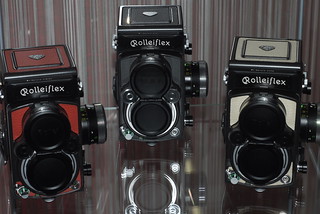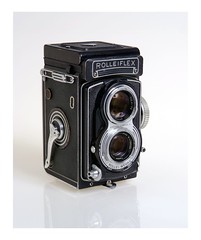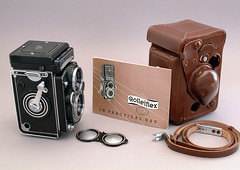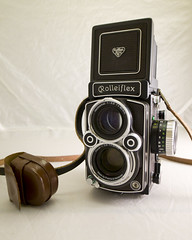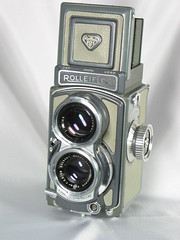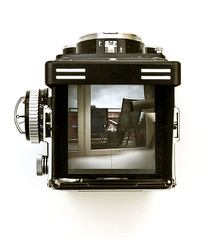Difference between revisions of "Rolleiflex"
(→Links) |
m (Updated LPA link) |
||
| (3 intermediate revisions by 3 users not shown) | |||
| Line 14: | Line 14: | ||
Rollei also used the name '''Rolleiflex''' for several ranges of [[Rollei#Medium Format SLR|medium-format SLR]] and [[Rollei#35mm SLR|35mm SLR]] cameras from the late 1960s to the 90s, one [[Rolleiflex SL26|SLR for 126 film]], and one digital camera. However, the name is most closely associated with the TLR cameras. | Rollei also used the name '''Rolleiflex''' for several ranges of [[Rollei#Medium Format SLR|medium-format SLR]] and [[Rollei#35mm SLR|35mm SLR]] cameras from the late 1960s to the 90s, one [[Rolleiflex SL26|SLR for 126 film]], and one digital camera. However, the name is most closely associated with the TLR cameras. | ||
| − | The Rolleiflex TLR was first made in 1927, shortly after the [[Rolleidoscop]], a [[stereo]] camera with a focusing reflex viewfinder, and might be seen as derived from it. A prototype TLR camera for 9x12 cm plates, dated to 1920, was made several years earlier,<ref>[ | + | The Rolleiflex TLR was first made in 1927, shortly after the [[Rolleidoscop]], a [[stereo]] camera with a focusing reflex viewfinder, and might be seen as derived from it. A prototype TLR camera for 9x12 cm plates, dated to 1920, was made several years earlier,<ref>[https://www.leitz-auction.com/en/Rolleiflex-Prototype-9x12/AI-24-27238 9x12 cm prototype 'Rolleiflex'] (not actually so named by Franke & Heidecke), with 15 cm f/4.5 Tessar lenses, and with both reflex and rear focusing screens, sold at the [https://www.leitz-auction.com/en/Cameras/Past-Auctions/Auction-24/ 24th Westlicht Photographica Auction], on 23 November 2013.</ref> but was never made commercially. |
With its simple construction and high quality optics, the TLR was a widely used professional camera, but the late fifties introduction of much more versatile SLR cameras in 35mm ([[Nikon]]) and 6x6 ([[Hasselblad]]) formats spelled the end. Rollei did later introduce SLR cameras but never regained their market position. | With its simple construction and high quality optics, the TLR was a widely used professional camera, but the late fifties introduction of much more versatile SLR cameras in 35mm ([[Nikon]]) and 6x6 ([[Hasselblad]]) formats spelled the end. Rollei did later introduce SLR cameras but never regained their market position. | ||
| Line 63: | Line 63: | ||
| image_text=Rolleiflex 4×4 | | image_text=Rolleiflex 4×4 | ||
|image_by= Takekazu Omi | |image_by= Takekazu Omi | ||
| − | |||
| − | |||
| − | |||
| − | |||
| − | |||
| − | |||
| − | |||
| − | |||
| − | |||
| − | |||
|image_rights= creative commons | |image_rights= creative commons | ||
}} | }} | ||
| Line 173: | Line 163: | ||
* [http://www.rolleigraphy.org/ Rolleigraphy] website by Ferdi Stutterheim | * [http://www.rolleigraphy.org/ Rolleigraphy] website by Ferdi Stutterheim | ||
* [http://www.butkus.org/chinon/rolleiflex.htm User manuals in color PDF] for various Rolleiflex models at [http://www.butkus.org/chinon/ Orphan Cameras] | * [http://www.butkus.org/chinon/rolleiflex.htm User manuals in color PDF] for various Rolleiflex models at [http://www.butkus.org/chinon/ Orphan Cameras] | ||
| − | * [http://www.collection-appareils.fr/x/html/page_standard.php?id_appareil=889 Rolleiflex I Original], | + | * [http://www.collection-appareils.fr/x/html/page_standard.php?id_appareil=889 Rolleiflex I Original], [http://www.collection-appareils.fr/x/html/page_standard.php?id_appareil=11679 Rolleiflex 2,8C], [http://www.collection-appareils.fr/x/html/page_standard.php?id_appareil=11680 Rollei Grey Baby] on [http://www.collection-appareils.fr/general/html/francais.php www.collection-appareils.fr] by Sylvain Halgand (in French) |
* [http://collectiblend.com/Cameras/search.php?param=Rolleiflex Rolleiflex Price Guide] by collectiblend | * [http://collectiblend.com/Cameras/search.php?param=Rolleiflex Rolleiflex Price Guide] by collectiblend | ||
* [http://www.thorleyphotographics.com/?page_id=42 Rolleiflex T review] at [http://www.thorleyphotographics.com Thorley Photographics] by Thorley Bros. | * [http://www.thorleyphotographics.com/?page_id=42 Rolleiflex T review] at [http://www.thorleyphotographics.com Thorley Photographics] by Thorley Bros. | ||
Latest revision as of 10:50, 19 January 2024
| |||
| German TLR () | |||
|---|---|---|---|
| 35 mm | Contaflex | Flexilette | Optima Reflex | ||
| 3×4 | Pilot Reflex | ||
| 4×4 | Baby Rolleiflex (1931) | Baby Rolleiflex (1957) | Karma-Flex | ||
| 6×6 | Altiflex | Amplion Reflex | Brillant | Flektar | Flexo | Flexora | Flexora II | Flexora III | Foth-Flex | Ikoflex 1 | Ikoflex II | Ikoflex Ia | Ikoflex Ic Ikoflex Favorit | Karma-Flex | Mentorett | Montiflex | Peerflekta | Perfekta | Photina Reflex | Plascaflex | Reflecta | Reflekta | Reflekta II | Rica Flex | Rocca Automatic | Rocca Super Reflex | Rolleiflex | Rolleicord | Rollop | Superb | Superflex | Trumpfreflex | Vitaflex | Weltaflex | Wirgin Reflex | Zeca-Flex | ||
| 6×9 | Superfekta | ||
Rolleiflex is the name of most of the 6×6 TLR cameras manufactured by Franke & Heidecke and later Rollei GmbH, in Germany. There was also a range of less expensively specified models named Rolleicord.
Rollei also used the name Rolleiflex for several ranges of medium-format SLR and 35mm SLR cameras from the late 1960s to the 90s, one SLR for 126 film, and one digital camera. However, the name is most closely associated with the TLR cameras.
The Rolleiflex TLR was first made in 1927, shortly after the Rolleidoscop, a stereo camera with a focusing reflex viewfinder, and might be seen as derived from it. A prototype TLR camera for 9x12 cm plates, dated to 1920, was made several years earlier,[1] but was never made commercially.
With its simple construction and high quality optics, the TLR was a widely used professional camera, but the late fifties introduction of much more versatile SLR cameras in 35mm (Nikon) and 6x6 (Hasselblad) formats spelled the end. Rollei did later introduce SLR cameras but never regained their market position.
One of the early Rolleiflex innovations was the speed winder whereby a single turn of the winder handle advanced the film and cocked the shutter. This seemingly simple innovation, which required quite complex gearing, transformed the camera especially compared to plate cameras that were still commonly used by press photographers well into the fifties. Popular with press and sports photographers, the camera was also used by many fashion photographers. The in lens leaf shutter meant flash could be used at any shutter speed and the reflex image was bright since the separate viewfinder lens had a large aperture.
The biggest disadvantage of a fixed lens was only partly addressed by versions with different focal lengths.
Contents
Rolleiflex TLR models
| ||
| ||
| ||
| ||
|
"Original", "standard" and f/3.5 models of Rolleiflex
- Original Rolleiflex 6×6 (1928-32)
- Rolleiflex old standard model 620 (1932-38)
- Rolleiflex old standard model 621 (1932-35)
- Rolleiflex old standard model 622 (1934-38)
- Rolleiflex 6×6 Automat Model 1 (1937-38)
- Rolleiflex 6x6 Automat Model 2 (1938-39)
- Rolleiflex 6x6 Automat Model 3 (1939-49)
- Rolleiflex 6x6 New Standard (1939-41)
- Rolleiflex 3.5 (Automat Model X) (1949-51)
- Rolleiflex 3.5 A (Automat Model 4) (1951-54)
- Rolleiflex 3.5 B (MX-EVS) (1954-56)
- Rolleiflex 3.5 C (1956-59)
- Rolleiflex 3.5 E2 Model 1 (1959-60)
- Rolleiflex 3.5 E2 Model 2 (1961-62)
- Rolleiflex 3.5 E3 (1961-65)
- Rolleiflex 3.5 F Model 1 (1958-60)
- Rolleiflex 3.5 F Model 2 (1960)
- Rolleiflex 3.5 F Model 3 (1960-76)
Rolleiflex 2.8
- Rolleiflex 2.8 A Model 1 (1949-51)
- Rolleiflex 2.8 A Model 2 (1951)
- Rolleiflex 2.8 B (1952-53)
- Rolleiflex 2.8 C (1952-55)
- Rolleiflex 2.8 D (1955-56)
- Rolleiflex 2.8 E (1956-59)
- Rolleiflex 2.8 E2 (1959-60)
- Rolleiflex 2.8 E3 (1962-65)
- Rolleiflex 2.8 F (1960-81)
- Rolleiflex 2.8 F 2/3 (1966-76)
- Rolleiflex 2.8 F 4 (1976-80)
- Rolleiflex 2.8 F Aurum (1982-84)
- Rolleiflex 2.8 F Platin (1984-90)
- Rolleiflex 2.8 GX Model 1 (1987-1994)
- Rolleiflex 2.8 GX Model 2 (1995-2000)
- Rolleiflex 2.8 FX (2002-current)
- Rolleiflex 2,8 FX-N (2013-current)
Rolleiflex 4x4 (Baby)
- prewar Rolleiflex 4×4 (Baby):
- Rolleiflex 4×4 (Baby) Model 1 (1931-33)
- Rolleiflex 4×4 (Baby) Model 2 (1933-34)
- Rolleiflex 4×4 (Baby) Model 3 (1934-38)
- Rolleiflex 4×4 (Baby) Model 4 (Sport) (1938-41)
- Rolleiflex 4×4 Kriegsmodell (War model) (1941-44)
- postwar 4×4 (Baby) Rolleiflex:
- Rolleiflex 4×4 (Baby) 1957 Grey (1957-63)
- Rolleiflex 4×4 (Baby) 1963 Black (1963-68)
Tele Rolleiflex
- Tele Rolleiflex (1959-74), 8,378 built
- Rolleiflex 4,0 FT (2007-current)
Wide-Angle Rolleiflex
- Wide-Angle Rolleiflex (1961-67)
- Rolleiflex 4.0 FW (2002-current)
Rolleiflex T series
- Rolleiflex T 1 (1958-66)
- Rolleiflex T 2 (1966-71)
- Rolleiflex T 3 (1971-76)
Rollei Magic
Actually not a real Rolleiflex but added here for sake of reference.
- Rollei Magic I (1960-62)
- Rollei Magic II (1962-68)
Notes
- ↑ 9x12 cm prototype 'Rolleiflex' (not actually so named by Franke & Heidecke), with 15 cm f/4.5 Tessar lenses, and with both reflex and rear focusing screens, sold at the 24th Westlicht Photographica Auction, on 23 November 2013.
Links
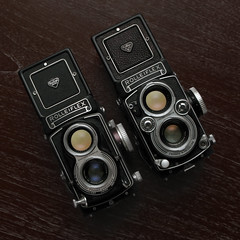
|
| Rolleiflex 3.5 T (left) and E3 image by Matt Phillips (Image rights) |
In English:
- Rolleiflex TLR Price & Model Identification Guide by Dan Colucci at www.antiquecameras.net
- All Rollei TLR by year at the International RolleiClub, a comprehensive overview with variants, specs, production estimates and serial numbers
- Rolleigraphy website by Ferdi Stutterheim
- User manuals in color PDF for various Rolleiflex models at Orphan Cameras
- Rolleiflex I Original, Rolleiflex 2,8C, Rollei Grey Baby on www.collection-appareils.fr by Sylvain Halgand (in French)
- Rolleiflex Price Guide by collectiblend
- Rolleiflex T review at Thorley Photographics by Thorley Bros.
In Italian:
